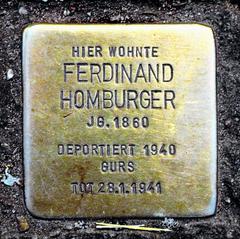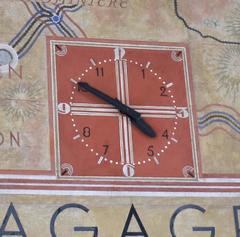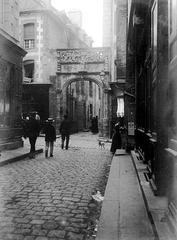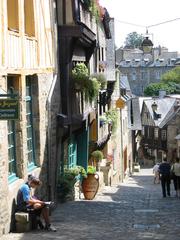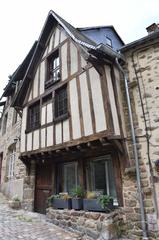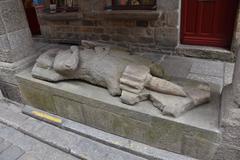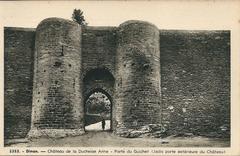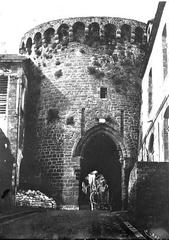Léhon & Dinan, France: Historical Sites Visiting Guide (Tickets & Hours)
Date: 14/06/2025
Introduction
Léhon, a charming village nestled along the Rance River in Brittany, France, offers visitors an immersive journey through medieval history, architectural marvels, and tranquil natural beauty. Just 2 km south of Dinan, Léhon is renowned for its iconic Abbey of Saint-Magloire and the evocative Château de Léhon ruins. This guide provides a comprehensive overview of Léhon’s rich heritage, practical visitor information, travel tips, and nearby attractions—ensuring you make the most of your visit to this “Petite Cité de Caractère®.”
Historical Background
Early Settlement & Roman Influence
Archaeological finds, such as megaliths and ancient burial mounds, attest to Léhon’s prehistoric significance in the Rance Valley (Nomads Travel Guide). During the Roman era, Léhon served as a strategic waystation on key trade routes, laying the foundation for its later rise as a spiritual and cultural hub.
Monastic Foundations & Medieval Growth
Léhon’s defining chapter began in 850 CE with the founding of the Benedictine Abbey of Saint-Magloire by King Nominoë of Brittany. The abbey’s acquisition of Saint Magloire’s relics soon made it a major pilgrimage site, catalyzing spiritual and economic growth in the region (Dinan-Cap Fréhel Tourism). Generous endowments from Breton nobility helped the monastic community flourish, shaping the village’s layout and daily life.
The Château de Léhon
Constructed in 1034 atop a rocky outcrop, the Château de Léhon guarded the abbey and the Rance crossing. Rebuilt in stone in the 12th century, the fortress played a vital defensive role during the Breton Wars of Succession and was repeatedly besieged and restored (Travel France Online). The ruins, with their characteristic towers and curtain walls, remain a testament to Léhon’s medieval prominence.
Architectural & Cultural Highlights
Abbey of Saint-Magloire
The abbey is the architectural heart of Léhon, blending Romanesque and Gothic styles. Notable features include:
- The Cloister: Tranquil arcaded galleries ideal for contemplation.
- Refectory: Gothic architecture highlighted by modern stained glass and 14th-century frescoes.
- Gardens: Restored monastic gardens with archaeological features, including a historic covered canal to the Rance (Brittany Tourism).
The abbey hosts regular concerts, art exhibitions, and seasonal cultural events, infusing new life into its ancient stones (French Moments).
Château de Léhon
The castle ruins offer panoramic views of the Rance Valley and the abbey. The site is open to visitors, with medieval-themed events and occasional guided tours in summer (Audiala).
The Village & Stone Bridge
Léhon’s village streets are lined with 17th-century stone houses, sculpted lintels, and floral displays. The donkey-back stone bridge, built in the 17th century, is a picturesque crossing point and a popular photo spot (France Voyage).
Monastic Gardens & Covered Canal
Adjacent to the abbey, the gardens are maintained according to monastic traditions and include archaeological remains of a covered canal, showcasing medieval water management ingenuity (Brittany Tourism).
Artisan Heritage
Léhon’s legacy of artisanal trades—such as sailcloth weaving and tanning—continues in local workshops, where you can purchase regional crafts and products.
Visiting Hours & Tickets
Abbey of Saint-Magloire
- Hours: Open daily (April–October) from 9:30 AM to 6:30 PM; shorter hours in winter. Some sources list 10:00 AM–6:00 PM—verify during planning.
- Tickets: Entry is generally free (donations appreciated). Some cultural events or guided tours may require a ticket.
- Guided Tours: Available during summer (June–September); book on-site or via the Dinan-Cap Fréhel Tourism website.
- Accessibility: Cloister and gardens are accessible; upper floors and some areas may be difficult for visitors with mobility issues.
- Restrictions: Pets and bicycles are not allowed inside abbey grounds.
Château de Léhon
- Hours: Open daily from sunrise to sunset.
- Tickets: Free entry; some summer events may have a fee.
- Accessibility: The site is uneven and not fully accessible for wheelchairs.
Getting There & Around
From Dinan
Léhon is just a 25–30 minute walk or a quick bike ride from Dinan along the scenic Rance River towpath (Nomads Travel Guide). Local buses connect Dinan and Léhon, and car parking is available near the abbey and across the river.
By Train
Dinan is accessible from Rennes (1 hour by train), with connections to Paris (under 4 hours). Regional buses link Dinan to Saint-Malo, Dinard, and other nearby destinations (Rick Steves).
By Bicycle
Flat towpaths and cycling routes make it easy to explore the Rance Valley. Bike rentals are available in Dinan (My French Life).
By Boat
River cruises and electric boat rentals offer a unique perspective of the towns and the valley (The Good Life France; Nomads Travel Guide).
Accessibility & Visitor Services
- Accessibility: The abbey cloister and gardens are accessible; castle ruins and some village streets are steep or cobbled.
- Wi-Fi: Free at tourist offices and various hotspots (Dinan-Cap Fréhel Tourism FAQ).
- Restrooms: Available at the abbey and in central Dinan.
- Baby Facilities: Baby carriers can be rented at the tourist office.
- Tourist Offices: Provide maps, event info, and booking for tours (Dinan-Cap Fréhel Tourism FAQ).
Accommodation & Dining
Dinan offers a range of hotels, B&Bs, and guesthouses, including Maison Pavie (a historic B&B with modern amenities) and Hôtel Le d’Avaugour (The Good Life France). Léhon has limited accommodation but plenty of charm.
Dining: Enjoy Breton galettes, fresh seafood, and the famous Kouign-Amann pastry. Local cider is a must-try. Recommended spots include Le Colibri (bistro), La Fontaine du Jerzual (creperie), and Léhon Abbey Bar/Restaurant for home-cooked meals (My French Life).
Events & Activities
- Markets: Dinan’s Thursday market is a highlight for local produce and atmosphere.
- Festivals: Summer brings concerts, art exhibitions, and medieval-themed events to both towns (Brittany Tourism).
- Walking & Cycling: The “Chouette boucle de Léhon” (6.5 km) is a scenic hike showcasing the area’s natural and architectural heritage (Dinan-Cap Fréhel Tourism).
Frequently Asked Questions (FAQ)
Q: What are the visiting hours for Léhon Abbey?
A: Generally 9:30 AM–6:30 PM (April–October); check official sources for updates.
Q: Is there an entrance fee for the abbey or castle?
A: Entry is usually free; donations appreciated. Some guided tours or events may have a fee.
Q: Are guided tours available?
A: Yes, in summer. Book via the tourism office or online.
Q: Is Léhon accessible for people with reduced mobility?
A: The abbey gardens and cloister are accessible; the castle and some streets are not.
Q: How do I get from Dinan to Léhon?
A: Walk or cycle the riverside towpath (2 km, about 30 minutes) or drive (parking available).
Practical Tips
- Best Time to Visit: Spring and early autumn for mild weather and fewer crowds.
- Footwear: Wear comfortable shoes for cobbled streets and hilly terrain.
- Parking: Free parking near the abbey and across the river; use extra-muros lots in Dinan.
- Language: French is primary; English is understood in tourist areas.
Plan Your Visit
Download the Audiala app for audio guides, interactive maps, and event schedules. Check Dinan-Cap Fréhel Tourism and Nomads Travel Guide for the latest hours, tickets, and tour info.
Summary
Léhon and Dinan together offer a rich tapestry of Breton history, from the spiritual serenity of the Abbey of Saint-Magloire to the evocative castle ruins and bustling medieval streets of Dinan. Their well-preserved architecture, lively markets, and riverside walks promise a memorable experience for history enthusiasts, architecture lovers, and casual travelers alike. For updated details and trip planning, consult the official resources below.
Official Sources & Further Information
- Dinan-Cap Fréhel Tourism
- Brittany Tourism
- Rick Steves: Brittany’s Dinan
- Nomads Travel Guide: Walking Tour of Dinan & Léhon
- Travel France Online: Léhon Castle
